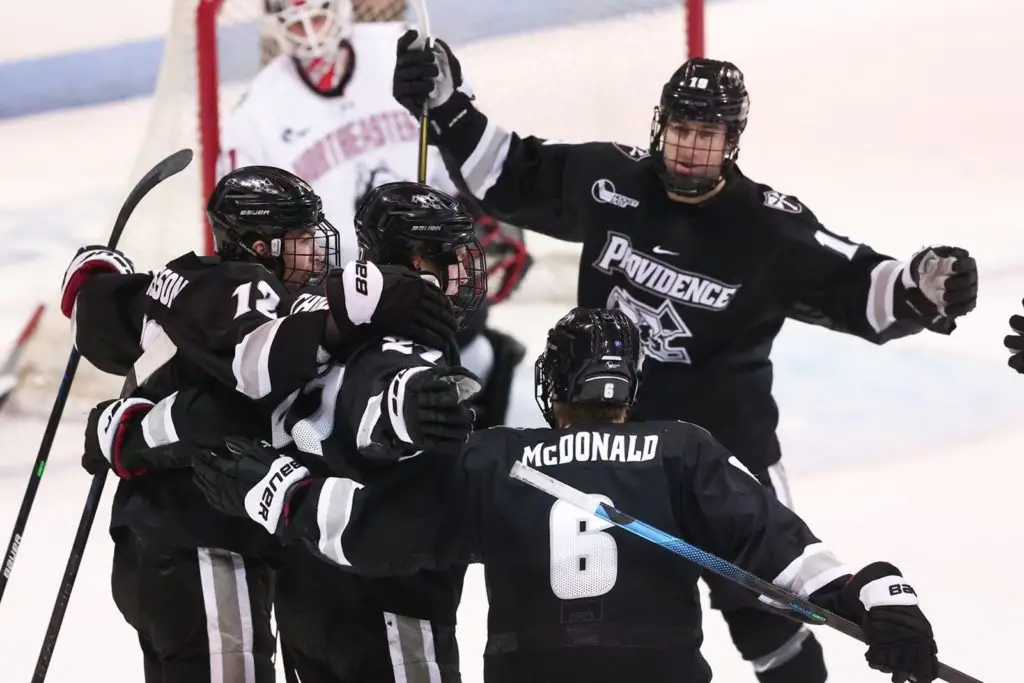
Each week during the season, we look at the big events and big games around Division I men’s college hockey in Tuesday Morning Quarterback.
Jim: Well, Paula, there’s a new No. 1 team as North Dakota has overtaken Boston College atop the USCHO.com poll.
It’s not too surprising as the divide between the two has been razor-thin over the past few weeks, so with Boston College slipping with a 3-2 overtime loss to Massachusetts in an entertaining battle on Friday, the Fighting Hawks, winners of five straight, were nearly unanimous as the top team.
Though the USCHO.com poll has often guided our discussion in this space over the years, I particularly want to look at it right now. In a year where using the PairWise to compare teams nationwide and select an NCAA field isn’t possible, I have to wonder if any credence will be given to both of the national poll when the NCAA committee and its two regional advisory committees come together on March 21 to select the at-large NCAA participants.
When I look at the current top 16 teams in the USCHO.com poll, it almost nearly matches the 16 teams I came up with when I tried to put together a current projected field. Not surprising, the spots where I don’t directly match the poll is at the bottom. So believe it or not, I feel the NCAA selection may not be as difficult or controversial as many have imagined.
Will there be a bubble like there is in most years? Yes. But I think the NCAA committee will be able to get to a field of 16 with relative ease.
Do you agree?
Paula: I do, Jimmy. Not only can I see the current top 16 teams comprising the entire NCAA tournament field, but I can see the current top four teams being the top four seeds, based on season-long performance and win percentages, plus perceived strength of schedule.
I don’t know everyone who votes on the USCHO.com poll, but even if there isn’t overlap with the NCAA committee, everyone on that committee is already part of the ongoing, season-long conversation we’ve all had about how to paint a national picture in a when competition is limited almost exclusively to intraconference play.
As you’ve said before, there is reason to have faith in the committee simply based on the expertise of each individual member, but there’s something to be said for each member’s participation in a wider community that has been concerned with this – publicly, actively – since the start of the season.
As I said last week, it’s a bit freaky how normal the top 10 look to me in this abnormal season, and even the PWR props up most of the top 10. There’s something to be said, too, for programs that are able to sustain a certain level of competition from year to year, and that has to be something that the committee can rely on.
Like you, most of my questions surround the bottom six teams in a field of 16 – but I’m always a little squishy in the bottom eight or so teams on my weekly poll ballot. What I mean by “squishy” is that I sometimes don’t see a lot of difference among teams that aren’t solidly top-tier in the country. After that definitive drop-off, a spot that varies season by season I think, we run into teams that aren’t performing with the same consistency as teams above them, and teams that are often inconsistent for a variety of reasons.
Sometimes these teams get it together by the end of the season. Sometimes they don’t. That’s where I think the committee may have difficulty.
I also wonder about how the committee will handle surprises in the conference playoffs. Maybe we’re making a case here, Jimmy, that they’ll pretty much do as they have in the past. I’m intrigued, though, by the subjectivity and flexibility hinted at in the memo we saw two weeks ago.
Jim: Here’s how I would see the discussions with both the regional advisory panel and the NCAA committee:
Heading into Saturday, when I believe five of the six conference championship games will be played (Big Ten tournament will be concluded), the two committees likely have generated a list of the 16 teams that would qualify IF the higher-seed wins the tournament. Should there be an upset that awards a team NOT on that list to receive the automatic qualifier, then the committee needs a “next team out” list. And then, if you have one or more upsets in the conference tournament, you begin bumping teams out, one by one.
This likely only impacts a maximum of four teams, maybe five. But in most likely scenarios, impacts just one or two. So while most committees in recent years might have simply waited for the PairWise to be calculated, this season might require a little more preparation. But all of this is something that could be ironed out prior to Selection Sunday and let the meeting on Sunday really be about what it has in the past – seeding the tournament and placing teams in regionals.
So yes, I feel like at the end of the day, things may be more normal that we all have been making out. But…
Let’s find a scenario where we could have some controversy.
Say, for instance, that the final two teams being considered for an at-large bid are Bemidji State and Providence (don’t send hate mail, I’m just trying to make a comparison). If you use the traditional PairWise formula to compare the two, the only category that has impact is RPI. Bemidji State has earned a higher RPI, but also has done so in a conference that some think isn’t as strong top to bottom as Hockey East.
At this point, would the regional advisory committees have to have a debate to determine which team gets in? It’s not supposed to, but does how each team performed in their conference tournament matter?
Questions like these are the major potential I see for controversy.
Paula: That is the kind of scenario that I’m sure is giving the committee members heartburn. There are fans out there – and maybe others among the press and certainly coaches of teams left out – that the choices made are indefensible precisely because there is no way to quantify a conference’s relative strength based on this season’s play alone.
I’m not trying to both-sides this at all, but the choices really are indefensible and completely defensible when we consider the words “flexible” and “subjective,” the second being the one that will garner the most attention.
I like the idea of flexibility on all kinds of levels. This season has been impossible, and yet we have the majority of D-1 teams nearing the completion of something extraordinary – a (relatively) normal, competitive hockey season. I think it will be years before we know the full story of how some teams made this happen, the lengths to which people went to stay safe, stay healthy, and to fight to produce something that connects so many people in a time of great disconnection.
I see the ability to be flexible key to juggling last-minute issues relating to COVID as well as some seeding and invitation choices.
That subjectivity, though, is where people think that is trickier than it is. The outcome of the example scenario that you bring up – Bemidji State or Providence – is bound to divide. The committee members, though, should make their choice in such a case, publish their rationale, and walk away from it after that, letting the conversation go where it goes.
Maybe that will lead to productive discussions about equity and conference strength. Maybe it won’t.
While I’m more of a proponent than most about performance within individual conferences in determining the field this year – and I think that conference play is super important overall, because it’s more equitable play on many levels – an argument for using the relative strength of individual conferences in recent years is valid.
Again, I don’t envy the committee.
This whole conversation, Jimmy, highlights something that we don’t discuss enough, in my opinion. We are always talking about growing the sport, and we all want college hockey to have a bigger footprint than it does. We know that the bigger it grows, the stronger and more viable it becomes as a nationwide product.
But I think people are especially nostalgic right now for the coziness of how college hockey used to be for all kinds of obvious reasons. What we don’t talk about, though, is that we are lucky in many ways that college hockey is as small as it is, that the NCAA committee is used to scheduling a field of only 16, that we only have six conferences and 60 teams to contend with.
I’m not advocating for keeping college hockey small, but the size of the sport does help with logistics right now and, beyond that, helps those of us in this community maintain a conversation and keep connected on a level that other sports communities cannot enjoy.
Jim: That’s a good point. I can’t imagine that the Men’s Division I Basketball Committee will have an easy go of it with plenty of scenarios around the nation mimicking what college hockey is going through this season.
Before we get to the NCAA tournament, of course, we do need to get through conference championships. That, itself, could be challenging. There will be more travel, potentially, than some teams have had to go through this season.
We look at Atlantic Hockey, which on the final week of the regular season had to cancel nine of 11 games within the conference. It feel ominous that potentially one or more teams across the six conferences could have their season ended because of a postseason COVID outbreak, one that could force games to be forfeited and teams to be eliminated without every playing a game.
Scary thought or am I just someone who sees the glass as half-empty too often?
Paula: I don’t think you’re seeing the glass as half empty at all. Hey, at least there’s a glass! We’re coming up on the one-year anniversary of mourning the abrupt end of the 2019-20 season. This year, teams will play for titles. Thinking about how the pandemic may affect the next few weeks isn’t pessimistic. It’s responsible.
I saw those cancellations and my heart sank. We know that COVID protocols can extend beyond a week or even two, and when so many teams are affected within the same conference, it’s natural to think of forfeiture and elimination. Every team must know that this is a possibility.
As we write this, I still haven’t heard what’s happening with Penn State. The Nittany Lions haven’t played since Jan. 29. Their first series in February against the Wolverines was cancelled because of COVID issues in the Michigan athletic department. Since then, it’s been all about tier-1 positive tests at Penn State. They may be out before the Big Ten playoffs begin. Even if they can return, how can they be competitive after a month without play?
Every time I see a story about COVID affecting a school where college hockey is played – even if the COVID protocols don’t currently affect the hockey team – I hold my breath and say a little prayer. We’d all hate to see seasons end now because of COVID with the end so near.
But, Jimmy, think of it this way: In December, I had serious doubts that we’d even get this far. None of us knew how COVID would affect our everyday lives in the coming months. With February behind us, I’m confident that teams will play for conference titles, that someone will earn a national championship.
Frankly, at this point an alternative is too much to think about.


